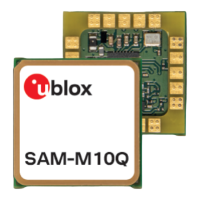SAM-M10Q-Integration manual
The UBX-INF-* and NMEA-Standard-TXT information messages are non-periodic output messages
that do not have a message rate configuration. Instead they can be enabled for each communication
interface via the CFG-INFMSG-* configuration group.
All message output is additionally subject to the protocol configuration of the
communication interfaces. Messages of a given protocol will not be output unless the
protocol is enabled for output on the interface. See Communication interface configuration
for details.
2.1.2 Navigation configuration
This section presents various configuration options related to the navigation engine. These options
can be configured through CFG-NAVSPG-* configuration keys.
2.1.2.1 Dynamic platform
The dynamic platform model can be configured through the CFG-NAVSPG-DYNMODEL
configuration item. For the supported dynamic platform models and their details, see Table 3 and
Table 4.
Platform Description
Portable Applications with low acceleration, e.g. portable devices. Suitable for most situations.
Stationary Used in timing applications (antenna must be stationary) or other stationary applications.
Velocity restricted to 0 m/s. Zero dynamics assumed.
Pedestrian Applications with low acceleration and speed, e.g. how a pedestrian would move. Low
acceleration assumed.
Automotive Used for applications with equivalent dynamics to those of a passenger car. Low vertical
acceleration assumed.
At sea Recommended for applications at sea, with zero vertical velocity. Zero vertical velocity assumed.
Sea level assumed.
Airborne <1g Used for applications with a higher dynamic range and greater vertical acceleration than a
passenger car. No 2D position fixes supported.
Airborne <2g Recommended for typical airborne environments. No 2D position fixes supported.
Airborne <4g Only recommended for extremely dynamic environments. No 2D position fixes supported.
Wrist Only recommended for wrist-worn applications. Receiver will filter out arm motion.
Table 3: Dynamic platform models
Platform Max altitude [m] Max horizontal
velocity [m/s]
Max vertical velocity
[m/s]
Sanity check type Max
position
deviation
Portable 12000 310 50 Altitude and velocity Medium
Stationary 9000 10 6 Altitude and velocity Small
Pedestrian 9000 30 20 Altitude and velocity Small
Automotive 6000 100 15 Altitude and velocity Medium
At sea 500 25 5 Altitude and velocity Medium
Airborne <1g 80000 100 6400 Altitude Large
Airborne <2g 80000 250 10000 Altitude Large
Airborne <4g 80000 500 20000 Altitude Large
Wrist 9000 30 20 Altitude and velocity Medium
Table 4: Dynamic platform model details
Applying dynamic platform models designed for high acceleration systems (e.g. airborne <2g) can
result in a higher standard deviation in the reported position.
UBX-22020019 - R01
2 Receiver functionality Page 11 of 72
C1-Public

